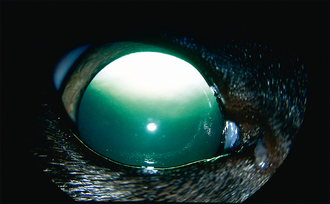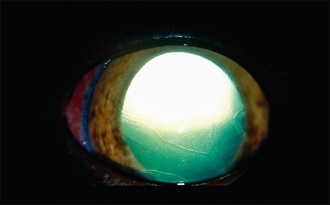46 Feline glaucoma
CLINICAL EXAMINATION
General clinical examination is frequently unremarkable. One or both eyes can be affected. The pupil is normally dilated and the direct pupillary light reflex absent or sluggish and incomplete (Figure 46.1). Moderate episcleral congestion is usually present but this can be difficult to appreciate since the globe fits tightly into the socket and there is little exposed sclera or episcleral tissue. Sometimes chemosis may be noted. Corneal oedema is not a common feature of feline glaucoma.
Signs of chronic uveitis might be present, and these could include keratic precipitates, rubeosis iridis, iris lymphoid nodules, posterior synechiae and iris rests (Figure 46.2).
The lens can be cataractous and is sometimes luxated into the anterior chamber. Another dissimilarity with dogs is that the luxated lens does not tend to further exacerbate the glaucoma and develops as a result of the uveitis damaging the lens zonules, not due to primary lens instability. Lens luxation in cats is less painful than in dogs since the anterior chamber can accommodate the dislocated lens without further exacerbating the glaucoma.
CASE WORK-UP
If the glaucoma is secondary to anterior uveitis, as is most common in cats, then the cause for the uveitis should be investigated and this is discussed in Chapter 34. If a uveal melanoma is suspected, the cat should be thoroughly assessed for signs of metastasis with blood work, radiography and ultrasonography. If there is no evidence of other intraocular disease, then a tentative diagnosis of primary glaucoma is made. It has been seen in Burmese and elderly Siamese cats on occasion, and the rare aqueous misdirection form mentioned briefly above can be seen in any cat breed. If a primary glaucoma is suspected, then referral should be considered, particularly to confirm this diagnosis and provide prognostic information for both eyes.
Stay updated, free articles. Join our Telegram channel

Full access? Get Clinical Tree




